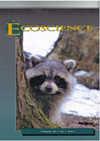加拿大中北部麦凯湖地区没有Treeline向北移动的证据
IF 1.3
4区 环境科学与生态学
Q3 ECOLOGY
引用次数: 0
摘要
近几十年来,北方和亚北极气候发生了重大变化,但生物群如何响应存在不确定性,例如,亚北极森林苔原(“树线”)是否会向北移动。西北地区麦凯湖区的地面植被数据用于确定是否有证据表明生物群落发生了北移。在树线附近,当前的植物群落与40-67年前记录的相似。最近树木通过种子再生、树木支架扩张或邻近苔原树木殖民的证据很少或没有。黑云杉茎需要75年才能达到2.5米的高度,并在摄影和卫星图像上被视为树木。20-30岁的树枝是从分层开始直立茎的首选年龄。森林中克隆云杉的直立茎-苔原可能比它们的近或地下茎年轻得多。北方生物群落迁移的发生地点取决于气候、景观和土壤因素、物种迁移能力、野火以及造林是否超过毁林。在森林苔原中,气候变化可能不会导致显著的生物群落变化,而是物种相对丰度的变化。摘要:过去几十年来,北方和亚北极气候发生了重大变化,但生物反应仍存在不确定性,例如,森林苔原(树木边界)是否会向北移动。西北地区麦凯湖地区的植被数据已用于寻找森林苔原向北迁移的证据。目前的植物群落与40-67年前相似,几乎没有或根本没有证据表明最近的种子再生、林分扩张或邻近苔原上的树木定居。黑云杉需要75年才能达到2.5米的高度,因此在航空照片或卫星图像中被识别为树木。树枝必须有20-30年的历史,才能通过分层开始直立茎的生长。森林苔原云杉克隆的直立茎可能比它们在地面或土壤中的树枝年轻得多。森林苔原向北迁移将取决于气候、景观和土壤因素之间的相互作用,以及物种迁移能力、森林火灾和造林对毁林的过度补偿。在森林苔原中,气候变化可能不是生物群落迁移的结果,而是已经存在的物种相对丰度的变化。本文章由计算机程序翻译,如有差异,请以英文原文为准。
No Evidence of a Northward Biome Shift of Treeline in the Mackay Lake Region, North-Central Canada
ABSTRACT Major changes in boreal and subarctic climates have occurred in recent decades, but uncertainty exists as to how biota are responding, e.g., whether the subarctic forest-tundra (‘treeline’) will advance northward. Ground-based vegetation data from the Mackay Lake region of the Northwest Territories were used to determine if there is evidence of a northward biome shift. Near the treeline, current plant communities are similar to those documented 40–67 years ago. There was little or no evidence of recent tree regeneration by seed, expansion of tree stands, or colonization by trees of adjacent tundra. Black spruce stems require ∼75 years to reach 2.5 m in height and be discernible as trees on photography and satellite imagery. Branches 20–30 years old are the preferred age for initiation of an upright stem from layering. Upright stems of clonal spruce within the forest-tundra may be far younger than their near-ground or belowground stems. Whether northward biome migration will occur will depend on the interplay between climatic, landscape, and soil factors, species migration capacities, wildfires, and whether afforestation outpaces deforestation. In the forest-tundra, climatic change may not result in significant biome shifts, but rather in changes in the relative abundance of species already present. RÉSUMÉ D'importants changements des climats boréal et subarctique ont lieu depuis quelques décennies, mais l'incertitude demeure quant à la réponse biotique, par exemple si la toundra forestière (la limite des arbres) avancera vers le nord. Des données de végétation prélevées dans la région du lac Mackay aux Territoires du Nord-Ouest ont été utilisées pour chercher des indices de migration de la toundra forestière vers le nord. Près de la limite des arbres, les communautés végétales actuelles sont similaires à celles d'il y a 40-67 ans. Il y a peu ou pas d'indices de régénération récente par graines, d'expansion de peuplements forestiers, ou de colonisation par les arbres de la toundra adjacente. Les épinettes noires nécessitent ∼75 ans pour atteindre 2,5 m de hauteur et ainsi être identifiées comme des arbres sur les photographies aériennes ou les images satellitaires. Les branches doivent avoir 20-30 ans pour initier la croissance d'une tige érigée par marcottage. Les tiges érigées des clones d'épinette de la toundra forestière pourraient être beaucoup plus jeunes que leurs branches au sol ou dans le sol. La migration vers le nord de la toundra forestière dépendra des interactions entre les facteurs climatiques, du paysage et du sol, ainsi que de la capacité de migration des espèces, des incendies forestiers, et de la surcompensation de la déforestation par l'afforestation. Dans la toundra forestière, les changements climatiques pourraient ne pas résulter en migrations de biomes, mais plutôt en changements des abondances relatives des espèces déjà présentes.
求助全文
通过发布文献求助,成功后即可免费获取论文全文。
去求助
来源期刊

Ecoscience
环境科学-生态学
CiteScore
2.80
自引率
0.00%
发文量
13
审稿时长
>36 weeks
期刊介绍:
Écoscience, is a multidisciplinary journal that covers all aspects of ecology. The journal welcomes submissions in English or French and publishes original work focusing on patterns and processes at various temporal and spatial scales across different levels of biological organization. Articles include original research, brief communications and reviews.
 求助内容:
求助内容: 应助结果提醒方式:
应助结果提醒方式:


